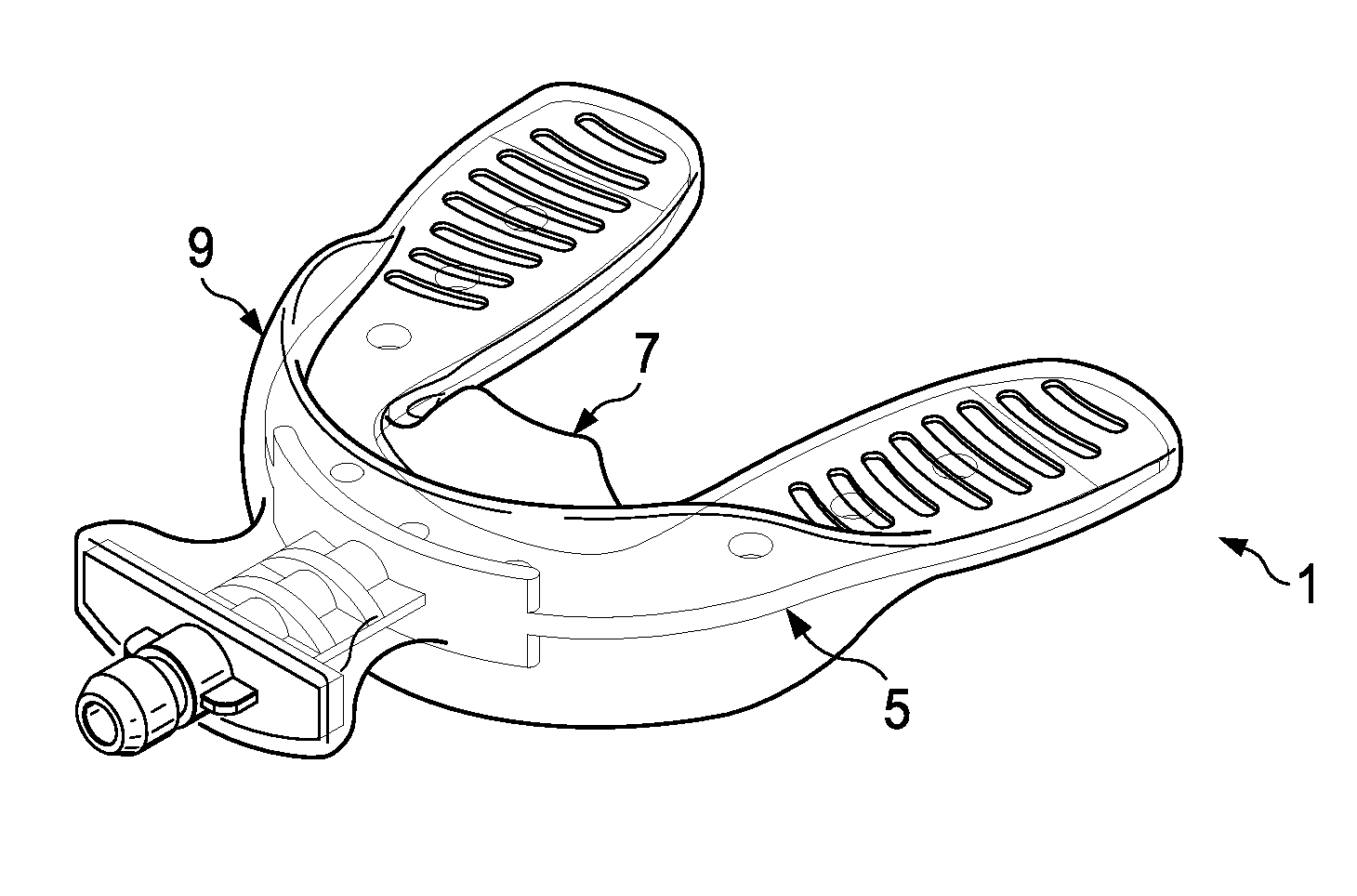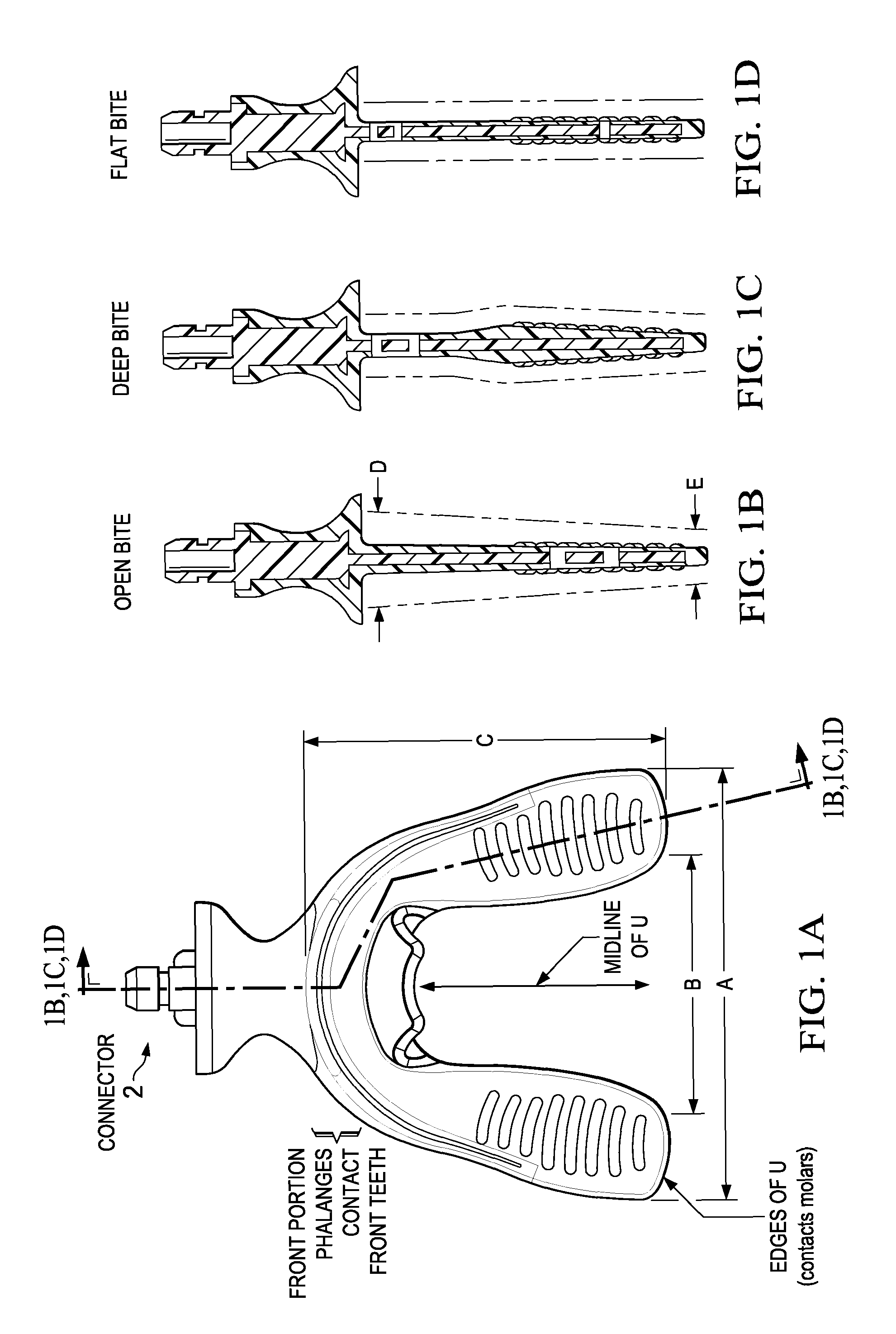Vibrating dental devices
a dental device and vibrating technology, applied in dental tools, dental surgery, medical science, etc., can solve the problems of cumbersome devices, difficult construction, high cost, etc., and achieve the effect of enhancing boney remodeling and speeding up boney remodeling
- Summary
- Abstract
- Description
- Claims
- Application Information
AI Technical Summary
Benefits of technology
Problems solved by technology
Method used
Image
Examples
example 1
[0048]The improved mouthpieces or bite plates are available in two sizes (small and large) based primarily on the anatomical dimensions of the patient's dental arches. Each size is available in three profiles based primarily on the type of malocclusion (open bite, deep bite and normal flat plane occlusion).
[0049]In the bite plates shown in FIG. 1, the phalanges that contact the lingual and buccal (inside and front) surface of the teeth are omitted for clarity, but such phalanges or edges are preferred since these edges allow greater contact with the teeth for improved comfort and improved transmission of the cyclic forces. Also shown in FIGS. 1B-D are optional ridges on the surface of the bite plate.
[0050]The sizes and profiles have been developed based on a statistical analysis of a sample population and are intended to allow for a maximum contact of teeth with the bite plate in a high percentage of patients and case types. The dimensions given in Table 1 are based on a minimum thi...
example 2
[0059]In a second embodiment, an improved extraoral vibrator has a more stable vibrator with improved performance characteristics of decreased sound and low variability frequency and force. In particular, the improved vibrator has a noise level less than 55 dB when measured at 6 inches, and preferably less than 50, 45, 40, or 35 dB. The improved vibrator provides a frequency at 20-40 Hz, preferably 30 Hz with a variance of only 2 Hz, and preferably 1 or 0.75 Hz. This is particularly important where the patient may move around during use, whereby lower quality vibrators may vary substantially with motion and / or orientation and thus provides an inconsistency that may be less efficacious, and may make FDA clearance of such a device more difficult. Further, the improved vibrator provides force at 0.1-0.5 Newtons, and preferably at 0.20 Newtons (20 grams) with a variance of ±0.05 N, and preferably less than ±0.03 N.
[0060]Consistency of frequency and force is achieved herein via a feedbac...
example 3
[0063]The bite plate of FIGS. 2A-D show the substantially U shaped bite plate 1 with clear overcoat 3 covering a stiff inner core 5 (shown as solid). Also shown is the lingual phalange or edge 7 for contacting the lingual surfaces of the teeth, in this instance only the front or anterior teeth (see labial area of FIG. 6A), and facial phalange 9 for contacting the facial surfaces of the teeth, as well as connector 2. The phalanges provide additional force transferring contacts with the teeth, but also aid in maintaining the correct position of the bite plate during use. Without the phalanges, the bite plate will vibrate away from the optimal position during use.
[0064]FIGS. 3A-D shows the details of the bite plate of FIGS. 2A-D, and FIGS. 4A-B includes sizing details of a preferred embodiment of the connector. In a basic configuration the connector 21 is a snap fit connector having a cylindrical shaft 23 that fits into a socket or receptacle on the vibrator. The shaft is of diameter 6...
PUM
 Login to View More
Login to View More Abstract
Description
Claims
Application Information
 Login to View More
Login to View More - R&D
- Intellectual Property
- Life Sciences
- Materials
- Tech Scout
- Unparalleled Data Quality
- Higher Quality Content
- 60% Fewer Hallucinations
Browse by: Latest US Patents, China's latest patents, Technical Efficacy Thesaurus, Application Domain, Technology Topic, Popular Technical Reports.
© 2025 PatSnap. All rights reserved.Legal|Privacy policy|Modern Slavery Act Transparency Statement|Sitemap|About US| Contact US: help@patsnap.com



